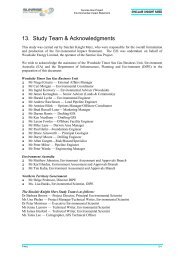Appendix D Terrestrial and Aquatic Biodiversity - Environment ...
Appendix D Terrestrial and Aquatic Biodiversity - Environment ...
Appendix D Terrestrial and Aquatic Biodiversity - Environment ...
Create successful ePaper yourself
Turn your PDF publications into a flip-book with our unique Google optimized e-Paper software.
SZ247: Bat survey from the Western Desert Resources Towns River project area, NT<br />
(the flattest part of the call, designated as Fpz in AnalookW software). Identifications were<br />
made based on a comparison of pulse shapes <strong>and</strong> measurements with those in Milne (2002).<br />
The recordings made with the D500x detectors were analysed using a hybrid automated –<br />
manual approach, given the significant memory size of the dataset (42.6 GB from MLA –<br />
Towns River; 26.9 GB from Rosie's Camp – Bing Bong) <strong>and</strong> the lack of a reference library set<br />
of calls in full spectrum format from the study area. Firstly, the WAV format files were<br />
converted to Zero Crossings files compatible with AnalookW software using the Anabat<br />
Converter ver. 0.3 Java batch utility written by Sikken (2012) (using automatic thresholding in<br />
50 ms chunks). Subsequently, the dataset was further reduced by employing a filter to<br />
exclude ZCA files containing only noise (relevant settings being: Smoothness 50, Body over<br />
2000 ms, Fc <strong>and</strong> Fmin 10 kHz minimum, Fmax 10 kHz minimum, Slope S1 -9999 to 9999,<br />
Duration 2 ms minimum). The resulting subset of ZCA files was examined in AnalookW<br />
software in a similar fashion to those recorded directly by AnaBat detectors. It is<br />
acknowledged that the WAV to ZCA batch conversion software does not perform as well as<br />
AnalookW software (K.N. Armstrong unpubl. obs.), <strong>and</strong> both programmes cannot readily<br />
distinguish calls buried in the sound floor, however for poorer quality ZCA files the<br />
spectrographic representation in the corresponding WAV file was examined to assist in the<br />
identification.<br />
The search phase echolocation calls of S. flaviventris <strong>and</strong> S. saccolaimus are very similar in<br />
structure <strong>and</strong> characteristic frequency, but both are readily distinguishable from molossid bat<br />
species based on their harmonic structure. In situations where calls with a characteristic<br />
below 25 kHz had features indicative of either Saccolaimus spp., Chaerephon jobensis or<br />
Mormopterus beccarii, the harmonic structure was examined in the WAV files, with<br />
Emballonuridae being distinguished from Molossidae based on the presence of a<br />
fundamental component around 10 kHz. The molossid species were distinguished from<br />
each other based on patterns of structure in successive pulses in the same sequence.<br />
Particular attention was paid to call sequences of Saccolaimus that contained approach <strong>and</strong><br />
feeding buzz calls, given some apparent differences noted in Asia by Corben (2010). In<br />
addition to details of that presentation, an unpublished AnaBat call dataset of S. saccolaimus<br />
from Cairns generously donated by Greg Ford was used as a basis for distinguishing the two<br />
species, but for nearly all call sequences, no distinguishing features were recognised.<br />
Several feeding buzzes with characteristics of S. flaviventris were noted, but none of the<br />
buzzes with relatively high characteristic frequency <strong>and</strong> serpentine pulse shape (cf. search<br />
phase pulses) were observed.<br />
3.4 Identification from acoustic recordings – limitations <strong>and</strong> considerations<br />
Several caveats <strong>and</strong> considerations are noted with regard to the identification of bat species<br />
based on recordings of their echolocation calls, of relevance to this survey:<br />
Two or more bat species may produce calls that are so similar that they cannot be<br />
distinguished reliably using the available methods or reference recordings (examples in<br />
Milne 2002).<br />
Page 9 of 33



